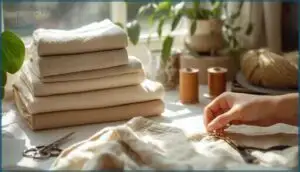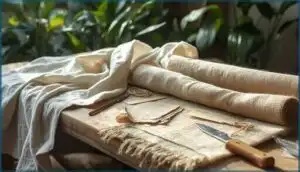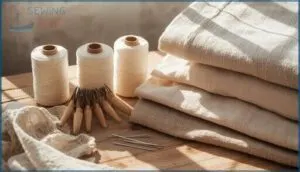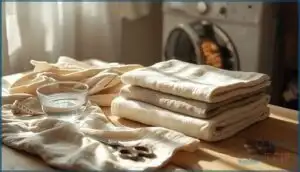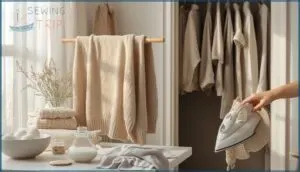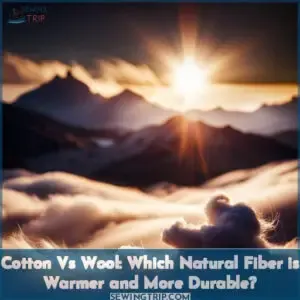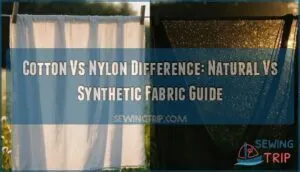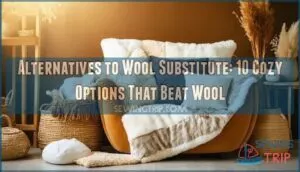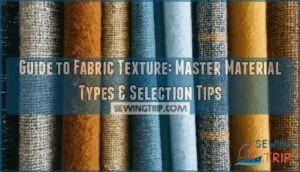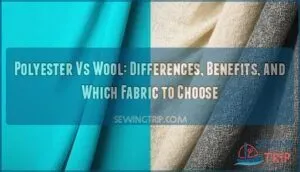This site is supported by our readers. We may earn a commission, at no cost to you, if you purchase through links.

Natural fiber sewing benefits extend beyond environmental responsibility into tangible advantages: excellent moisture-wicking keeps garments fresh, hypoallergenic properties protect sensitive skin, and inherent durability means your handmade pieces withstand years of wear.
Whether you’re cutting into organic cotton for a summer dress or selecting wool for a winter coat, these fibers offer versatility that synthetic alternatives struggle to match.
Table Of Contents
- Key Takeaways
- Key Advantages of Sewing With Natural Fibers
- Environmental Benefits of Natural Fiber Sewing
- Durability and Longevity in Finished Projects
- Versatility and Aesthetic Appeal
- Health and Safety Benefits for Sewers
- Practical Tips for Sewing With Natural Fibers
- Frequently Asked Questions (FAQs)
- Conclusion
Key Takeaways
- Natural fibers like cotton, linen, and wool offer superior breathability, moisture-wicking, and comfort compared to synthetics.
- Choosing natural fibers helps reduce environmental impact by avoiding microplastic pollution and supporting biodegradability.
- These materials are durable, resist pilling, and retain color and texture, making your handmade pieces last longer.
- Natural fibers tend to be hypoallergenic, gentle on sensitive skin, and safer due to minimal chemical residue.
Key Advantages of Sewing With Natural Fibers
When you choose natural fibers for sewing, you get more than just a beautiful finish.
These materials offer practical benefits that make your projects stand out and feel great to wear. Here’s what you can expect from sewing with natural fibers.
Enhanced Breathability and Comfort
Comfort plays a key role when you sew with natural fibers. Breathable fabrics like cotton and linen allow air circulation, keeping you cool and dry. Wool’s structure traps air, balancing warmth and breathability for thermal regulation.
These materials conform gently to your skin, offering superior skin comfort. With their open weave, natural fibers create a soft, biodegradable microclimate you’ll appreciate.
Additionally, choosing natural fibers can provide numerous benefits for skin health, including reduced irritation from skin friendly fabrics.
Superior Moisture Management
You’ll notice how natural fibers excel at moisture management. Thanks to hydrophilic properties and capillary action, cotton and linen wick away sweat quickly, keeping you dry. Wool absorbs up to 30% of its weight without feeling damp.
Try these moisture-wicking benefits for:
- Breathable fabrics during activity
- Natural fibre blends for enhanced comfort
- Quick moisture absorption
- Biodegradable performance.
Consumers also prefer natural fiber options for their comfort and sustainability.
Hypoallergenic and Skin-Friendly Properties
Moving from moisture management, you’ll appreciate how natural fibers like cotton and linen offer hypoallergenic, skin-friendly comfort. If you struggle with skin irritation or fiber sensitivity, these breathable fabrics are a safer bet.
Their natural textures minimize friction, and allergy prevention is built in—organic options skip harsh chemicals. That’s why biodegradable, skin-friendly textiles remain the top choice for sensitive skin.
Antimicrobial and Odor-Resistant Qualities
If you’re looking for fresher garments, natural fibers like wool and hemp excel at microbial inhibition and odor resistance. Thanks to breathability and moisture-wicking, they’re less likely to trap sweat or bacteria. Fiber treatments using natural sanitizers also boost antimicrobial testing scores.
Here’s what you’ll gain:
- Reduced laundry needs
- Biodegradable freshness
- Sustainable odor control
- Hypoallergenic protection
Environmental Benefits of Natural Fiber Sewing
Choosing natural fibers for your sewing projects has a real impact on the planet. These materials bring distinct environmental benefits you won’t get from synthetics.
Let’s look at the specific reasons why natural fiber sewing really matters.
Biodegradability and Compostability
Ever wonder how your fabric choices affect what happens after the project’s done? Natural fiber waste, such as cotton or linen, returns to the earth in months, not centuries. These biodegradable textiles break down quickly through common compost methods, unlike synthetics.
Natural fiber waste like cotton and linen returns to the earth in months, not centuries, breaking down quickly through composting unlike synthetics
By choosing sustainable textiles, you support eco-friendly disposal—closing the loop with ecofriendly materials that naturally enrich soil.
Reduced Carbon Footprint
A lower carbon footprint is built right into natural fiber sewing. Your choice of cotton, linen, or hemp means you’re using eco-friendly, sustainable textiles that release far less carbon than synthetics.
Green production, renewable energy, and carbon offset techniques make these ecofriendly textile materials leaders in sustainability.
Biodegradability closes the loop—true support for our planet’s well-being.
Lower Microplastic Pollution
Microplastic reduction isn’t just a buzzword—it’s a reality with natural fibers. When you choose eco friendly materials like cotton or wool, you’re helping keep oceans cleaner. Consider this:
- Natural fibers don’t shed persistent microplastics during laundering.
- Fiber biodegradation means rapid breakdown in soil and water.
- Sustainable textiles support ocean pollution prevention and truly biodegradable materials—key to sustainable fashion.
Sustainable Sourcing and Certifications
Did you know over 90,000 sites worldwide now carry textile certifications? Choosing Eco Labels like Fair Trade or GOTS means your sewing promotes Organic Farming, Supply Chain transparency, and true Sustainability. Textile certifications guarantee ecofriendly practices and Biodegradability, making sustainable fashion more than a trend—it’s a standard.
| Eco Labels | Certification Standards |
|---|---|
| Fair Trade | GOTS, FSC |
| European Flax | Masters of Linen |
Durability and Longevity in Finished Projects
When you choose natural fibers for your sewing projects, you’re investing in materials that stand the test of time.
These fabrics offer practical benefits that keep your creations looking and feeling their best. Here’s what sets them apart in terms of durability and longevity.
High Tensile Strength and Wear Resistance
Imagine your project holding up through years of use—thanks to the impressive Fiber Reinforcement and Material Durability of natural fibers like hemp and linen. Tensile Testing shows hemp canvas outperforms cotton in strength, while Wear Analysis confirms their resistance in Composite Materials.
These Fiber properties mean your sewing lasts longer, supporting Sustainable fashion with Biodegradability and superior durability.
Long-Lasting Color and Texture
Ever wondered why your linen shirt keeps its crisp look season after season? Natural fibers excel in Color Fastness and Texture Stability, especially with optimized Dye Fixation and Light Resistance. You get:
- Lasting vibrancy through sophisticated dye techniques
- Fiber Durability for repeated wear
- Minimal fading under sunlight
- Biodegradability supporting Sustainable fashion
Resistance to Pilling and Abrasion
Just as natural fibers hold their color, they also stand up well to everyday wear. You’ll notice impressive Pilling Resistance and Fiber Durability, especially in tightly woven cotton and linen. Abrasion Testing shows these fabrics shed pills easily, keeping surfaces smooth.
Material Strength and Wear Performance mean your projects stay looking fresh, while Breathability and Moisturewicking properties add comfort for years.
Versatility and Aesthetic Appeal
When you work with natural fibers, you’ll notice how much freedom you have to shape your projects. The look and feel can shift dramatically depending on your choices.
Here’s what makes these materials so adaptable and visually appealing.
Variety of Textures and Finishes
Texture blending sets the stage for creative freedom in your sewing projects. You’ll see cotton’s matte poplin, linen’s crisp slubs, and wool’s velvety tweed—all shaped by distinct fiber surfaces and fabric weaves.
Finishing techniques and natural dyes add depth, letting you explore:
- Matte to lustrous finishes
- Visible textures
- Handcrafted color effects
Sustainability meets artistry in every stitch.
Natural Drape and Handfeel
As you explore fabric flow, you’ll notice how natural fibers excel in drape coefficient and fiber flexibility. Cotton and linen, for example, move with your body, offering comfort and breathability.
Wool’s textile softness and natural weave add warmth, while modal’s fiber characteristics create a gentle touch. That’s why durability and graceful movement go hand-in-hand with these materials.
Ease of Dyeing and Customization
If you appreciate how cotton and linen move with you, you’ll love their ease of dyeing and customization. Natural fibers excel at Dye Uptake, so you get vibrant Custom Prints and deep hues from Natural Pigments. Eco Dyeing methods support Sustainable fashion, and you’ll notice:
- Strong Color Fastness
- Quick Customization
- Ecofriendly processes
- Endless design possibilities
Health and Safety Benefits for Sewers
When you choose natural fibers for sewing, you’re not just making a creative choice—you’re also looking out for your well-being.
These materials offer unique health and safety advantages that can make your sewing experience more comfortable.
Here’s what you can expect when you work with natural fibers.
Reduced Exposure to Harmful Chemicals
Ever wondered how much safer your sewing could be with Chemical Free Fabrics? When you choose Eco Friendly Textiles like Organic cotton or hemp, you sidestep toxic dyes and residues found in synthetics.
Sustainable Dyes and Organic Materials mean fewer harmful chemicals touch your skin. That’s one of the biggest Natural Fiber Benefits—making your projects truly Sustainable and Biodegradable.
Safer Handling and Fewer Allergens
Allergen reduction starts at the fiber. With natural fibers like cotton and wool, you’re tapping into chemical-free materials that help minimize skin sensitivity and allergic reactions.
Breathable and absorbent by design, these textiles support better skin safety and fiber hygiene, lowering respiratory health risks and making your sewing projects gentler on skin—no harsh surprises under the surface.
Gentle on Sensitive Skin
Sensitive skin demands gentle handling, and that’s where natural textiles shine. Dermatologist insights consistently point to untreated cotton and linen as top choices for reducing skin irritation and fiber allergies.
You’ll notice less redness and fewer flare-ups from clothing, especially important for people dealing with eczema. Choosing natural fibers truly helps skin sensitivity, making your sewing projects feel as comfortable as they look.
Practical Tips for Sewing With Natural Fibers
Working with natural fibers brings its own set of quirks and rewards. Knowing how to handle them can save you frustration and help your projects shine.
Here are a few key tips to make your sewing experience smoother from start to finish.
Choosing The Right Needle and Thread
The right needle and thread pairing is your foundation for strong, beautiful seams.
For medium-weight cotton and linen, you’ll want a universal 80/12 needle with cotton or polyester corespun thread to optimize seam strength and fabric compatibility.
Match your thread weight to needle sizing—about 40% of the needle’s diameter prevents skipped stitches and maintains stitch quality while supporting sustainability in the textile industry.
Pre-washing and Shrinkage Considerations
Think of fabric shrinkage as a hidden surprise that can derail your entire sewing project if you skip pre-washing. Natural fibers like cotton shrink 3–5%, while wool can reach 8–10%. Pre-washing removes sizing chemicals, sets dyes, and ensures your finished garment maintains its fit after laundering. This simple sewing preparation step protects garment longevity and prevents disappointing alterations later.
- Measure fabric length before and after pre-washing to track dimensional changes
- Wash natural fiber care fabrics in low temperatures to minimize excessive shrinkage
- Add 5–10% allowance in patterns to compensate for expected natural fibers movement
Proper Care for Longevity
Caring for natural fibers the right way can double or even triple your garment’s lifespan. Gentle washing with cold water and mild detergents reduces fiber breakage by 40%, while air drying extends cotton and wool life by 50%. Storage conditions matter too—cool, dark spaces preserve strength up to 80% longer than humid or sunlit areas.
| Care Practice | Key Benefit | Impact on Longevity |
|---|---|---|
| Hand washing or gentle cycle | Reduces fiber breakage | Up to 40% less wear |
| Air drying flat or line drying | Prevents shrinkage and heat damage | 50% lifespan extension |
| Cool, dark storage with breathable bags | Minimizes UV fading and moisture buildup | 80% longer fiber strength retention |
You’ll get the most out of durability and longevity by adjusting cleaning frequency based on fiber type. Wool’s natural odor resistance lets you wear garments 3–10 times between washes, slowing fiber fatigue by 60%. Cotton withstands about 200 cycles under ideal care requirements, but harsh bleaching cuts this nearly in half. Ironing techniques also play a role—use low to medium heat with a pressing cloth to maintain fabric integrity and retain original shape 20% better over time. Shrinkage concerns ease when you combine proper washing care with ideal drying methods, protecting your investment while honoring the eco-friendly nature of natural materials.
Best Applications for Different Fiber Types
Once you’ve nailed care techniques, matching natural fibers to projects unlocks their full potential. Cotton’s 33% share of global textile consumption makes it your go-to for everyday t-shirts and bed linens, while wool dominates 70% of formal suiting in Europe. Hemp-blended denim saw 30% growth in eco fashion, and silk defines 90% of luxury evening wear—proof that sustainable materials and textile innovation enhance both plant-based fibres and animal-based fibres across the textile industry.
- Cotton breathability transforms summer garments and medical textiles into comfort essentials you’ll reach for daily
- Wool’s natural resilience creates structured suits and performance sportswear that outlast synthetic alternatives season after season
- Silk’s luxurious drape brings evening wear and bridal gowns to life with peerless elegance and sustainability
Frequently Asked Questions (FAQs)
How do natural fibers compare to synthetic blends?
A cotton dress shirt breathes and absorbs moisture naturally, while polyester traps heat and sheds microplastics.
Natural fibers biodegrade, offer enhanced breathability, and reduce chemical exposure compared to synthetic blends’ durability advantages.
What are the best natural fibers for beginners?
For beginner projects, cotton and linen offer the best combination of stability and ease. Their breathability and plant-based fibres resist fraying, simplifying sewing techniques while supporting eco-friendly, organic cotton choices in natural textures.
Can natural fibers be used for outdoor projects?
Wondering about outdoor durability? Natural fibres can work outdoors with proper treatments.
Hemp and flax offer decent weather resistance, but moisture management and UV protection require wax coatings or water repellents to prevent decay and fading.
How does climate affect natural fiber sewing choices?
Climate directly shapes your natural fiber sewing choices. UV Degradation fades colors and weakens fibers, Humidity Effects reduce strength, and Temperature Impact causes brittleness.
Weather and environmental factors, like droughts, influence Climate Sourcing and demand careful Fiber Maintenance for longevity.
What are common challenges when sewing with natural fibers?
Sewing with natural fibers often means dealing with Fiber Shrinkage after washing, Thread Breakage, Fabric Fraying at cut edges, Seam Stability issues, and Weaving Issues.
These durability concerns require careful handling and proper care to maintain fiber characteristics.
Conclusion
Nearly 80% of textiles in landfill are synthetic, a sharp contrast to the path you choose with natural fibers. Every stitch in cotton or linen carries not just longevity, but a quieter footprint.
The natural fiber sewing benefits don’t end at personal comfort—your projects embody breathable design, safety for sensitive skin, and a gentle approach to the planet.
When you sew, you craft more than clothing; you’re building a legacy of mindful, resilient creativity in every thread.
- https://www.tandfonline.com/doi/full/10.1080/15440478.2025.2462218
- https://www.eco-stylist.com/a-guide-to-the-most-and-least-sustainable-fabrics/
- https://lifestylemonitor.cottoninc.com/heres-why-brands-are-leaning-into-natural-fibers/
- https://shepherdsdream.com/blog/sleep-healthy-living/skin-natural-fibers/
- https://www.inspirethemind.org/post/beyond-the-label-how-synthetic-fibres-impact-our-health


